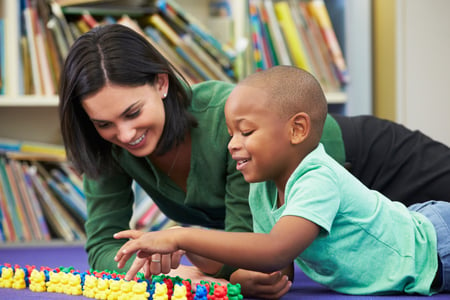
Concept Development can be a tricky dimension to wrap your head around, but when you really consider the meaning, the fog starts to lift!
Before I get to the indicators of Integration and Connections to the Real World, let’s take a look at this dimension as a whole. Remember that an indicator describes a behavior that shows us the presence or absence of interactions that, when seen together, give us a picture of the overall quality of interactions. Indicators tell us what kinds to interactions to look for during the course of an observation and we use them to gather evidence. So to get started, let’s take a deeper look at the dimension and its definition.
In Concept Development, we look at how a teacher participates with a child, through discussion or activities in ways that build understanding of how things fit together, how they relate to other knowledge and apply to a child’s world by leading the child through the steps of inquiry. When done well, teachers help children make connections to big ideas and help them start to make sense of information.
We start by thinking of a concept as a notion or conceived idea and development as something advanced over time, or in this case process. Helping children examine information methodically so they are able to discover essential elements, consider, figure out, inspect and internalize their experience is a critical skill and the essence of Concept Development.
A teacher who is focused on Concept Development will encourage the kids to ponder, share ideas, and try out new ideas that lead to a greater understanding of how information fits together. We look for teacher encouragement that results in a child investigating something new: It’s all about how the teacher uses discussion to really stretch the child’s brain, to ask the questions that help the child and teacher explore the world together.
With effective facilitation, children can figure out how things fit together, anticipate what might happen (Analysis & Reasoning) or understand how things relate by thinking of ways to try things out (Creating). As adults, we need to find ways to integrate this knowledge and connect it to real world experiences so that this experience build the child’s ability to take in information and make it fit into the way the world works.
So what is Integration? Simply put, it’s how information is consolidated or combined –the new information, coupled with previous knowledge, builds cognition. It’s the mental action or process of acquiring knowledge and understanding through thought, experience, and the senses.
Connections to the Real World is about how the child, with support from an adult, links, associates, or relates this information to something they understand already. The information becomes meaningful and usable and this connection to the abstract becomes the essence of Concept Development.
Remember that children learn when they are actively involved, experiencing and exploring, making connections and seeing the world with new eyes. Teachers who join the journey can promote those higher order-thinking skills.

